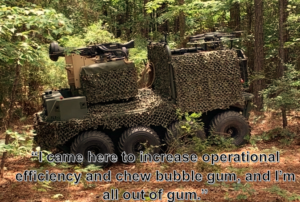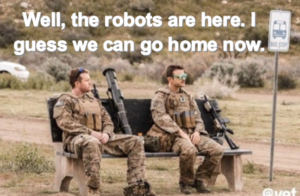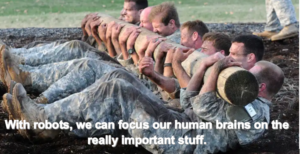The Opposing Force (also known as Geronimo), or Soldiers pretending to be the bad guys, at the Joint Readiness Training Center (JRTC) at Fort Polk, Louisiana has one job: to give other Army units their worst day in a training environment so they don’t have a similar experience in combat. In September 2021, the Army decided to give Geronimo Soldiers a pair of Robotic Combat Vehicle (RCV) prototypes so they could provide user feedback to support the Army’s on-going modernization effort. While the Soldiers provided invaluable feedback to better define vehicle requirements, the Army learned a lesson that transcends the RCV’s development and applies to the advancement of every robotic and autonomous system and optionally crewed vehicles: artificial intelligence increases the human element’s operational efficiency.
So how does a pair of RCV prototypes fighting an Infantry Brigade Combat Team in a miserable Louisiana swamp relate to a dealership’s fixed operations? Well, regardless if you belong to a sniper team or work in a parts department, you will perform tasks that fall into two categories: complex or routine. A complex task requires abstraction, or developing a creative solution to a problem, while a routine task addresses a problem that requires the same answer as it did during countless previous iterations. Let’s at a look at some examples:
- Complex Army Task: Infiltrating through dense vegetation at night to establish an observation post overlooking an enemy position.
- Complex Fixed Operations Task: Dealing with a dissatisfied customer whose alternator has remained on backorder for three weeks.
- Routine Army Task: Blocking a road intersection for 36 hours.
- Routine Fixed Operations Task: Scheduling an appointment to resolve a safety recall.
At JRTC, the Army learned that when you off-load the routine tasks on robots enabled with a rudimentary level of AI, you can re-task more Soldiers to perform complex tasks [read: high value tasks]. During the training event, Geronimo’s leadership ordered the formation to block a key road intersection. This task typically required 30 Soldiers to establish fighting positions and remain in place for at least 36 hours. Geronimo made the decision to assign two RCV prototypes and their 5 crew members to perform this task and re-assigned the 30 Soldiers to support a complex infiltration mission. With robots and AI, 5 Soldiers achieved the same effect that normally required 25 additional people.
Now, let’s define the operational efficiency delta between blocking the road intersection with 30 Soldiers vice 5 Soldiers and robots. In this case, we’ll define our operational efficiency metric as labor productivity {how much input (Soldiers) must Geronimo apply to achieve a desired output (blocking a road intersection)}. To this end, we’ll calculate the operational efficiency of blocking this road intersection using the following equation: (Total Output/Total Input) = Labor Productivity[1]. Let’s run the numbers:
(1 Road Intersection Blocked/30 Soldiers)= .03 Road Intersection Blocked per Soldier
(1 Road Intersection Blocked/5 Soldiers & Robots) = .2 Road Intersection Blocked per Soldiers & Robots
These results conclude that offloading a routine task (blocking a road intersection for 36 hours) on an element equipped with robotics and autonomy was 83% more efficient than performing the same task with a pure-human element. Also, consider some of the more subjective benefits. Robots do not get tired nor do they get bored. They are able to focus on their assigned task without requiring food, sleep, or mental respite. In theory, those robots could still be vigilantly blocking that same road intersection while you read this as long as they had fuel to charge their on-board batteries.
Think about the number of routine tasks to which your dealership assigns a human when artificial intelligence can serve as an efficient substitute. To be clear, humans and machines both have their own strengths. To date, science has yet to invent a super computer that can simultaneously solve complex problems (also known as abstraction) better than the human brain. Further, the human brain has the ability to continue to train itself to solve harder problems as long as it has access to the correct inputs and stimuli. True, we can train an artificial intelligence to perform a single complex task (ref: Google AI defeating the world’s best Go player here), but we are still decades away from what data scientists refer to as “artificial general intelligence.”[1]
And while we patiently await our beloved concept of Skynet to manifest, we can agree on a simple premise: machines crunch data faster and more accurately than humans do. We can then apply this knowledge to the operations of any given dealership and begin to identify tasks that we can offload on machines so actual humans can handle higher priority tasks. For example, let’s say your dealership must schedule 1000 repair orders in response to the recent Dodge Heavy Duty fuel pump recall. A good BDC will spend 66.7 hours (assuming each appointment requires four minutes to book) handling this workload. An interactive artificial intelligence can handle this task without requiring a single minute of your staff’s time. Further, consider how much time your staff spends pouring through OEM data to find the customers who own a Dodge Ram that meets the recall criteria. Again, your staff will spend hours of their valuable time performing a task that a machine can do in seconds.
The Auto Labs team excels at increasing your team’s operational efficiency. Our Sophi Customer Experience (CX) technology unburdens your staff from the mundane tasks so they can focus on delivering an output crucial to your dealership’s success: customer advocacy driven by elite personal service. Sophi CX handles the routine tasks leading to this moment so your staff can focus their efforts to provide the best possible experience for your customers the minute they arrive. As the old saying goes, if everything is a priority, then nothing is a priority. Make the personal human interaction the priority; let machines handle everything else.
Regardless if you find yourself sitting in a swamp with a pair of Army robots or developing a plan to tackle an upcoming recall campaign, ask yourself one question: will my available resources achieve the maximum output? Granted, people have written dissertations while answering this question, but for the sake of brevity, let’s go back to our lonely road intersection in the Middle-of-Nowhere, Louisiana. In both scenarios (30 Soldiers or 5 Soldiers equipped with robots enabled with artificial intelligence) Geronimo blocked the aforementioned road intersection; the difference was that robots and artificial intelligence enabled Geronimo to accomplish their mission with 83% less human effort.
We are confident that leveraging emerging technology, such as Sophi CX, can deliver similar results in your organization. Please contact us today and learn how we can help your team achieve the highest levels of efficiency and deliver the elite personal service that your customers deserve.
[1] Nick Heath defines Artificial General Intelligence as a machine being “capable of understanding the world as well as any human, and with the same capacity to learn how to carry out a huge range of tasks.” https://www.zdnet.com/article/what-is-artificial-general-intelligence/
[1] How to Calculate Workplace Productivity | Smartsheet
Want to learn more about how Sophi CX can increase your team’s operational efficiency?






